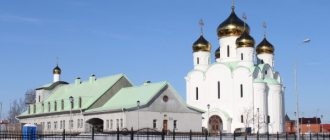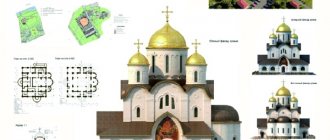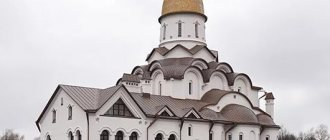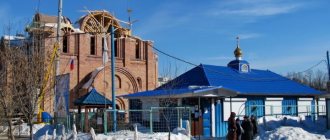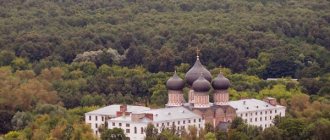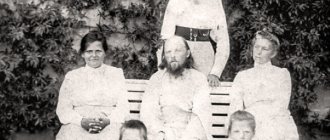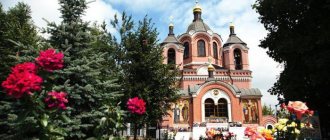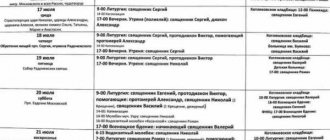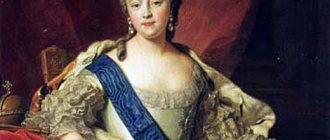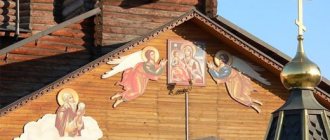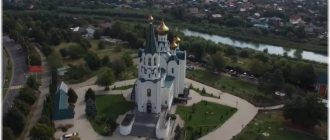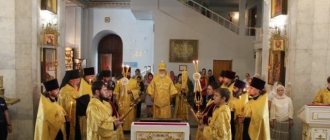Throughout the history of its existence, the Mother of God Church in Krylatskoye has been reborn from the ashes more than once in the literal sense of the word. Its building rises among the protected nature of the Krylatsky Hills and looks like a divine oasis against the backdrop of the urban landscape of modern Moscow.
Church of the Nativity of the Blessed Virgin Mary in Krylatskoye
Temple of Hermogenes in Krylatskoye today
The temple building is located on the site of the patriarchal courtyard in Krylatskoye. The Temple of Hermogenes is not the only one with this name. According to Patriarch Kirill, its construction says that the Russian people honor their faith and the people who died for it and for the glory of their fatherland. The construction sponsor was AFK Sistema.
The management of the company, led by Mr. Yevtushenkov, voluntarily expressed a desire to invest in this building, which has become a cultural center for believers.
Temple of Hermogenes in Krylatskoye, Moscow
The Temple of Hermogenes in Krylatskoye was opened in the fall of 2015. The construction of the temple is of great historical and cultural significance for the entire country. The holy martyr, originally from the Don Cossacks, was born in 1530 and was named Ermolai by his parents.
He grew up during great events for the country:
- capture of Kazan;
- conquest of Siberia and Astrakhan;
- accession to the throne of Ivan IV (the Terrible);
- meeting of the first zemstvo councils and the appearance of the Code of Laws.
In addition to these events, there were also not very joyful ones for the Russian people. Poland, which had captured part of the Russian lands, stubbornly propagated its Catholic faith. All this was difficult for a Russian believer like Hermogenes.
The main goal of the young priest was to serve the Church, the Fatherland and the Orthodox people. Having begun his ministry in the Gostinodvor church of Kazan, a simple parish priest firmly believed in Orthodoxy and knew how to speak with people. He read a lot, studying not only church, but also secular literature.
The Metropolitan was an educated and comprehensively developed person. He had an outstanding mind, constantly studied historical books, sacred manuscripts and chronicles. Hermogen wrote a service to the Mother of God in honor of the Kazan Icon.
The main events of his life were as follows:
| Period | Description |
| 1579 | A miraculous appearance of the Kazan Icon of the Mother of God took place. It was the young presbyter who showed it to the people, solemnly with a festive church procession, transferring it to St. Nicholas Church. This greatly influenced the strengthening of Ermolai’s faith, and he took monastic vows as a nun. His name was given to him by Hermogenes. From that time on, the Chudov Monastery became special for him. |
| 1587 | He became the archimandrite of the Kazan Spaso-Preobrazhensky Monastery. |
| 1589 | Ermogen became a bishop, and a few months later received the rank of Metropolitan of Astrakhan and Kazan. The main task of the clergyman was missionary activity to convert Muslims and people of other faiths to Orthodoxy. |
| 1606 | The Council of Hierarchs placed Saint Hermogenes on the patriarchal throne. It was a difficult time, which was later nicknamed the Troubles. But even in the most difficult situations, His Holiness the Patriarch resisted people who betrayed the Fatherland, giving the people into the hands of Polish Catholics. They decided to eradicate Orthodoxy in Rus'. |
| 1608 | When a riot arose in support of False Dmitry, Ermogen persuaded the rebels not to cross the line. After all, this will bring a lot of trouble not only to the Russian people, but also to the relatives of the rebels themselves. During the famine in Moscow, grain bins were opened for starving citizens at the order of the patriarch. Hermogenes supported the servants of the Trinity-Sergius Lavra in their desire to prevent Polish-Lithuanian invaders from entering the monastery. Despite a 16-month siege by numerous enemy detachments, they never conquered the Russian priests. Patriarch Hermogenes himself at this time appealed to the people, calling on them to defend the Fatherland and faith. When False Dmitry was killed, the boyars wanted to elevate the Poles to the throne. In response, the Patriarch spoke out against the traitors and began convening a militia. The icon of the Kazan Most Holy Theotokos became a symbol of the faith of the militia. The uprising was led by Kozma Minin and Prince Pozharsky. Moscow was on fire, Hermogenes himself was dethroned and sent to the Chudov Monastery. |
| 1611 | After a months-long siege, the militia took the Kremlin. All this time, the Poles more than once sent messengers to Hermogenes, demanding that the rebels be stopped. But even under pain of death, the Saint said that only God could command him. If they leave voluntarily, then they will be allowed through the ranks of the militia. Otherwise, the Russian people will stand until the end. Addressing his people, he called on them to free the country from foreigners, even at the cost of their lives. Saint Hermogenes spent more than 9 months in captivity. |
| 1612 | Starved to death, Hermogenes died in February. |
The death of the patriarch inspired the militia, and they broke the enemy's resistance in a difficult battle. The saint's courage was highly appreciated by his descendants. His body was buried in the Chudov Monastery. When it was decided to transfer his relics to the Assumption Cathedral, located in the Kremlin, more than 40 years had passed since his death. When opened, his relics remained incorrupt. This spoke of the holiness of Hermogenes.
In 1913, Patriarch Hermogenes was canonized. Services are held in his honor on May 25 and March 1.
Temple shrines
The relics of the temple are:
- Icon of the Mother of God “Rudnenskaya”.
- Icon of St. Nicholas.
- Relics of Saint Job of Anzersky.
- Icon and reliquary with the relics of the holy martyr Boniface.
Rudny Icon of the Mother of God
The image received its name from the place where it was found - the village of Rudnya. In 1687, a priest named Vasily took the icon to the Kyiv Pechersk monastery. Since 1712, the icon was kept in the Frolovsky Monastery.
In the mid-19th century, a copy of the icon was acquired by residents of the village of Krylatskoye. During the haymaking season, while relaxing by the stream, the peasants discovered a wooden board with an image of the face of the Mother of God. Later, parishioners built a chapel on this site, and the find was placed in a local temple. Molebens were served in front of the Rudny icon and water brought from the spring was blessed. In 1917, Patriarch Tikhon of Moscow held a service at the holy spring.
In 1936, when the church was closed and looted, the women of the village sewed dresses from the priests' service vestments. One of the desecrators of the holy place broke and burned the icon of the Mother of God. Heavenly punishment in the literal and figurative sense befell the blasphemer. During a fascist air raid, a woman died.
The church preserves a holy image that belonged to Paraskeva Mukhina. The icon was created at the beginning of the 20th century. In 1990, Mukhina's granddaughter and heir Lydia Gruzdeva donated the family heirloom to the Church of the Nativity of the Blessed Virgin Mary in Krylatskoye . Remembrance Day of the icon is celebrated on October 25.
Face of Saint Nicholas
In the last century, the icon of St. Nicholas was located above the gate of the Sachs weaving factory in Kuntsevo. After the Bolsheviks came to power, the holy face was thrown into a barn, from where it was picked up and taken home by a peasant from the village of Krylatskoye. The descendants of the pious villager transferred the image of St. Nicholas the Wonderworker to the restored temple.
Saint Nicholas has been venerated in Russia since ancient times. There is not a single temple in which a copy of the icon of the Miracle Worker of Myra is not kept. Russian naval commanders consider him the patron saint of seafarers. In difficult everyday situations, parishioners seek help from the heavenly intercessor.
Relics of St. Job of Anzersky
Being the confessor of Peter the Great, the Monk Job was slandered. By royal decree, Father Job went into exile to the Solovetsky Monastery. For many years, the monk, who took a vow of silence, lived in the Anzersky monastery. His ascetic life in the northern regions and the founding of a hermitage monastery earned him the respect of the Arkhangelsk brethren. On the day of the death of the holy monk, the cell was illuminated with divine light. Prayers addressed to Job relieve sadness and give spiritual strength to overcome persecution and reproach. An ancient lithograph and particles of Job’s relics were donated to the temple by Hieromonk Eulogius.
Relics of Saint Boniface
The Roman Boniface, who lived in the 3rd century, went to the Asia Minor city of Tarsus to redeem the relics of the martyrs from the pagans. Having witnessed the torture of Christians , he openly declared his faith in Jesus Christ. The executioners beheaded Boniface with a sword. In 2010, philanthropists N. Mezentseva and K. Mireysky donated an icon and a particle of the saint’s relics to the temple. Prayers to the martyr and a lit candle promote healing from illnesses, especially drug addiction and alcoholism.
Healing spring
The holy spring, near which the “Rudnenskaya” icon appeared, was famous in the ancient Moscow state. Water from the stream was delivered to the Kremlin for the needs of the royal court of Ivan the Fourth. At present, the water in the spring is considered the cleanest in Moscow. People who sincerely believe in the power of God receive healing from diseases in this place. Every year on the patronal feast day, on Epiphany and on the day of remembrance of the Rudny Icon, a procession of the cross descends to the spring for a prayer service and the ceremony of blessing the water.
Architect, exterior decoration, architectural ensemble
The architect of this object was Mrs. Skugareva.
During the construction of the temple, a strict style was chosen, without decorations and luxury:
- it organically combines the Russian style of architecture and elements of the Dutch Baroque;
- above the entrance there is a belfry with bells and a small dome;
- a baroque tent was created above the temple, a little higher there is a dome in the form of an onion;
- in the east there are 3 altars in the form of a semicircle;
- The area around the temple is well-groomed: paths have been laid and flower beds have been laid out. Parishioners love to relax here;
- a bronze monument to Patriarch Hermogenes was erected;
- in the evening the area in front of the temple is consecrated with forged lanterns.
Interior decoration
The interior work is not yet finished, so the interior will change. There are no frescoes on the walls and ceiling. They are whitewashed and striking in their whiteness, decorated with icons of saints.
The altar is separated by a 3-level iconostasis in the Baroque style. It is decorated with gilding and carving elements. Among the main icons is the face of Hermogenes. According to tradition, the iconostasis is crowned with an Orthodox cross and an image of the Lord.
Clergy, mentors
Currently there are three priests serving in the parish:
| Priest | His way |
| Archpriest Andrei Mironov |
|
| Archpriest Alexey Konstantinov |
|
| Priest John Novikov |
|
In addition to the above-mentioned priests, other dignitaries can conduct services in the temple. In some cases, the liturgy may be conducted by the Patriarch or other high officials of the Russian Orthodox Church.
History[edit]
The modern Church of the Nativity of the Virgin Mary was built on the site of several earlier wooden churches belonging to the former village of Krylatskoye, and the first mention of a village church in these parts dates back to 1554. Then, according to the chronicle, Tsar Ivan the Terrible, whose patrimony was Kryletskoye (Krylatskoye), stayed in the village on the occasion of the consecration of a temple there in the name of the Nativity of the Virgin Mary. The church building that was erected at that time burned down in 1713 and soon after that a new wooden church was built in its place, which stood until the middle of the 19th century. At the request of parishioners of Krylatskoye and surrounding villages, in 1862, construction began on a new stone church with two side chapels, which could accommodate a significantly larger number of believers, on the site of a wooden church. The main temple and refectory were ready in 1868, while the bell tower began to be built a few years later and was completed only in 1877. The architect of the temple was R. T. Vodo, and the bell tower was erected according to the design of the Moscow architect A. N. Stratilatov. The stone church was built under the abbot of priest Pyotr Aleksandrovich Orlov, who served in the village. Krylatsky from 1838 to 1876.
From the end of the 19th century until the 1930s, the icon of the Rudny Mother of God was kept in the Church of the Nativity of the Virgin, which, according to legend, was found by local peasants not far from the temple. A chapel was built near the place where the icon was found, and the spring located there, one of the streams flowing through today’s landscape park, is still considered miraculous and residents of surrounding houses come there for water.
In 1936, the original image of Our Lady of Rudny was stolen and burned, and the church was finally closed in 1941, while the chapel at the spring was dismantled, and the bell tower of the temple was destroyed by Soviet anti-aircraft gunners as a possible reference point for German planes during the bombing of the western outskirts of Moscow. However, until the mid-50s of the last century, services on some holidays secretly continued to be held in the officially closed, dilapidated church, which were finally stopped during the years of Khrushchev’s persecution of the church. Subsequently, the surviving main church building was used for a long time by village residents as a wood storage facility. During the demolition in the 1970s of the Krylatskoye village, which had previously been part of Moscow, for the construction of Olympic facilities and a new residential area, the dilapidated church remained the only surviving building of the former village, and both parish cemeteries near the church were also destroyed, and the graves were moved to the Khovanskoye cemetery.
In 1989, the temple building was returned to the Russian Orthodox Church and soon services resumed there. In the 1990s, the bell tower was restored, the territory of the temple was landscaped, and a new iconostasis was created to replace the lost original. The icon of Our Lady of Rudny, currently located in the church, is a copy of the lost icon preserved at one time by one of the local residents, made at the beginning of the 20th century. Since 2003, work has been underway to restore the interior paintings of the church.
In subsequent years, the temple continued to be restored, a new iconostasis was created, the area occupied by the temple was expanded, a clergy house was built, and the area surrounding the temple was landscaped. Since 1990, a Sunday school and an Orthodox library have been operating at the temple. In 1998, Archpriest Georgy Breev became the rector of the temple.
On February 8, 2010, a particle of the relics of the martyr Boniface was transferred to the Church of the Nativity of the Virgin Mary in Krylatskoye.
Parish and choir of the temple
In the Church of Hermogenes in Krylatskoye, a folk choir sings with the participation of parishioners. In addition, there are singers who train those who want to sing. Classes are held regularly in the Sunday school premises. Anyone who has expressed a desire and loves church singing can participate.
The folk choir performed the Liturgy of St. Basil the Great - a beautiful chant, difficult to perform. The temple choir includes not only Sunday School students, but also secular youth and believing parishioners. The regent of the combined choir is Victoria Kulikova. The team has repeatedly helped in holding services, especially holiday ones.
Social life of the monastery
Not only religious services are held in the temple . A Sunday school “Rodnik” has been opened at the church, staffed by:
- Music class.
- Art studio.
- Martial arts club.
- Creative handicrafts group.
A psychological support center and courses in Orthodox disciplines are open for adults. The parish library has an extensive collection of literature on church history, theology, and the works of the holy fathers. Volunteers help lonely and elderly parishioners with housekeeping. The church operates a collection and distribution point for clothing.
Social work, everyday life
In addition to daily services, the servants of the Temple of Hermogenes are engaged in social activities, which are carried out in the following areas:
- Sunday school classes, where children from 5 years of age and adults learn the basics of faith;
- Conducting discussions in the form of seminars and lectures. The issues that are addressed in them relate not only to theology and philosophy of belief, but also to the everyday problems of parishioners, so everyone attends them;
- pilgrimage tours. Parishioners can visit holy places and learn new things about them from a guide;
- providing assistance to the needy, disabled and elderly people without families. Such raids are often carried out by administrative commissions;
- works on improvement and maintenance of order in the temple and the territory not adjacent to it;
- conducting a class in a choral singing group.
The clergy of the Church of St. Hermogenes in Krylatskoye
The plans of the ministers:
- training those interested in bell ringing;
- forming drawing circles for children of different ages;
- organizing events that attract representatives of the younger generation to the temple;
- organization of a library on Orthodoxy.
Current state and activities of the parish
Today the Church of the Nativity of the Blessed Virgin Mary is operational. Divine services are held regularly.
Divine service in the Church of the Nativity of the Blessed Virgin Mary, Krylatskoye
The temple conducts active social activities.
- A Sunday school is open here, accepting students from 7 to 16 years old.
- Adults can attend catechetical courses.
- There is a charity group at the temple. It consists of 15 people, among whom are professional nurses. Members of the group help elderly and seriously ill people. They prepare food, clean, and provide financial support. There is also a collection of clothes that are donated to orphanages and prisons.
- An Orthodox psychologist receives an appointment at the temple premises. On Wednesdays, from 18:00, parishioners can come for a free consultation with a lawyer. Reception is carried out by prior appointment.
Sunday School
The Temple of Hermogenes in Krylatskoye has a Sunday school, headed by Olga Vladimirovna Kirilova. The school opened in 2015. Here children are given the basics of religious education. After 4 years of study, children are given a special diploma.
Teachers are called upon to educate children within the framework of the Orthodox religion and the commandments of Christ. Such education can be the beginning of the formation of a kind person who empathizes with other people’s troubles, who believes in God and keeps his commandments.
The set is open throughout the year to all parishioners and guests:
| Group | Description |
| Junior | This includes children under 7 years of age. Teachers try to conduct classes in a playful manner so that children do not get tired and during the games they get acquainted with the History of the Old and New Testaments, the basis of Orthodox culture |
| Average | This group includes children under 11 years of age. Here a more in-depth acquaintance with the Law of God, Holy Scripture and other fundamentals of faith takes place. Singing classes are also offered |
| Older | Children up to 15 years old study here. In addition to studying important Orthodox laws, their classes include discussions on music and the arts, including painting, sculpture and cinema. |
Creative activities are provided for young children under 5 years old. It is planned to create an adult group of students in the Sunday school.
According to tradition, every school lesson begins with prayer and general tea drinking. At this time, you can congratulate birthday people and give small gifts.
At the beginning of each school year, trips are organized to see the shrines. Matinees and exhibitions of student work are often held.
Schedule of services in the Church of the Nativity of the Blessed Virgin Mary in Krylatskoye
From early morning until late evening, the doors of the church are open to everyone who wants to pray and attend church services - liturgy and vespers are held daily. The temple in Krylatskoye has the following schedule of services:
| Service name | Weekdays | Holidays |
| Liturgy | 9-00 | 7-00 10-00 |
| Vespers | 17-00 | 17-00 |
| Service name | Weekdays | Holidays |
| Liturgy | 9-00 | 7-00 10-00 |
| Vespers | 17-00 | 17-00 |
Interesting facts about the temple in the surrounding area
Church ministers try to provide all possible assistance to those in need. Together with social services and volunteers, they help their wards. The volume of work that was carried out before the pandemic has increased several times. Four volunteers took care of war and labor veterans and the nearby psychoneurological boarding school No. 20. The parish has a support group for the disabled people's club.
Psychoneurological boarding school No. 20
The following events were also carried out:
- annual fair with piano concert;
- the opening of an Orthodox film club, which attracted young people;
- organizing a concert of the Ballroom Dance Studio with a historical twist. The event was held in honor of the 405th anniversary of St. Hermogenes;
- in honor of Victory Day, the event “Let's remember everyone by name” was timed;
- Patriarch Kirill's speech in the church in honor of its consecration and the consecration itself;
- holding a seminar on information ministry;
- arrangement of a temporary temple.
Every Sunday, Gospel readings are held , beginning with prayer singing.
The ministers and the volunteers who help them work closely with the rehabilitation center where drug addicts are treated. They try to instill faith in them and their families by holding spiritual conversations and organizing joint meetings.
The temple has no less close ties with the Central City Library named after. Svetlova for youth. Together they created a discussion club to help young people solve moral and spiritual problems.
Information for pilgrims
The temple servants conduct active pilgrimage activities. For example, on January 2, 2022, a group of young people, together with Priest John Novikov, visited the shrines of the Vladimir land. They visited the Assumption Cathedral, examining this monument of Russian architecture, which became a model for the creation of many other cathedrals.
Consecration of the temple by Patriarch Kirill
Parishioners touched such shrines as icons: Vladimir and Maksimov, as well as holy relics. Such events take place regularly. The tour schedule can be found on the temple website.
Recently, parishioners have visited:
- an ancient Moscow temple to venerate its shrines;
- Hermogen Hermitage for pilgrimage purposes;
- A tour of the temple was given to schoolchildren.
Patronal holidays[edit]
Nativity of the Blessed Virgin Mary
- September 21
Icons of the Mother of God of Rudnenskaya - October 25
Cathedral of the Prophet, Forerunner and Baptist of the Lord John
- January 20th
Hieromartyr Zosima, Presbyter of Krylatsky - November 2
Where is it located, what is in the surrounding area, how to get there
You can get to the temple by your own car or by public transport. In this case, you need to get to the station. Krylatskoye metro station, then take bus No. 829 or No. 850. You need to get off at the stop. "Autumnaya, 25".
By car from the center of the capital you need to go to Marshal Zhukov Avenue. After driving along it a little, turn onto Krylatskaya, and then onto Osenniy Boulevard.
Temple address: Moscow, st. Osennyaya, 32, building 1.
The memory of the Patriarch of All Rus' Hermogenes is kept in the memory of the people and his followers. Temples in his honor, built in Tushino and Krylatskoye, contribute to this. For modern man, faith is as important as in Troubled Times. Everyone should make an effort to preserve it and the history of the country.
